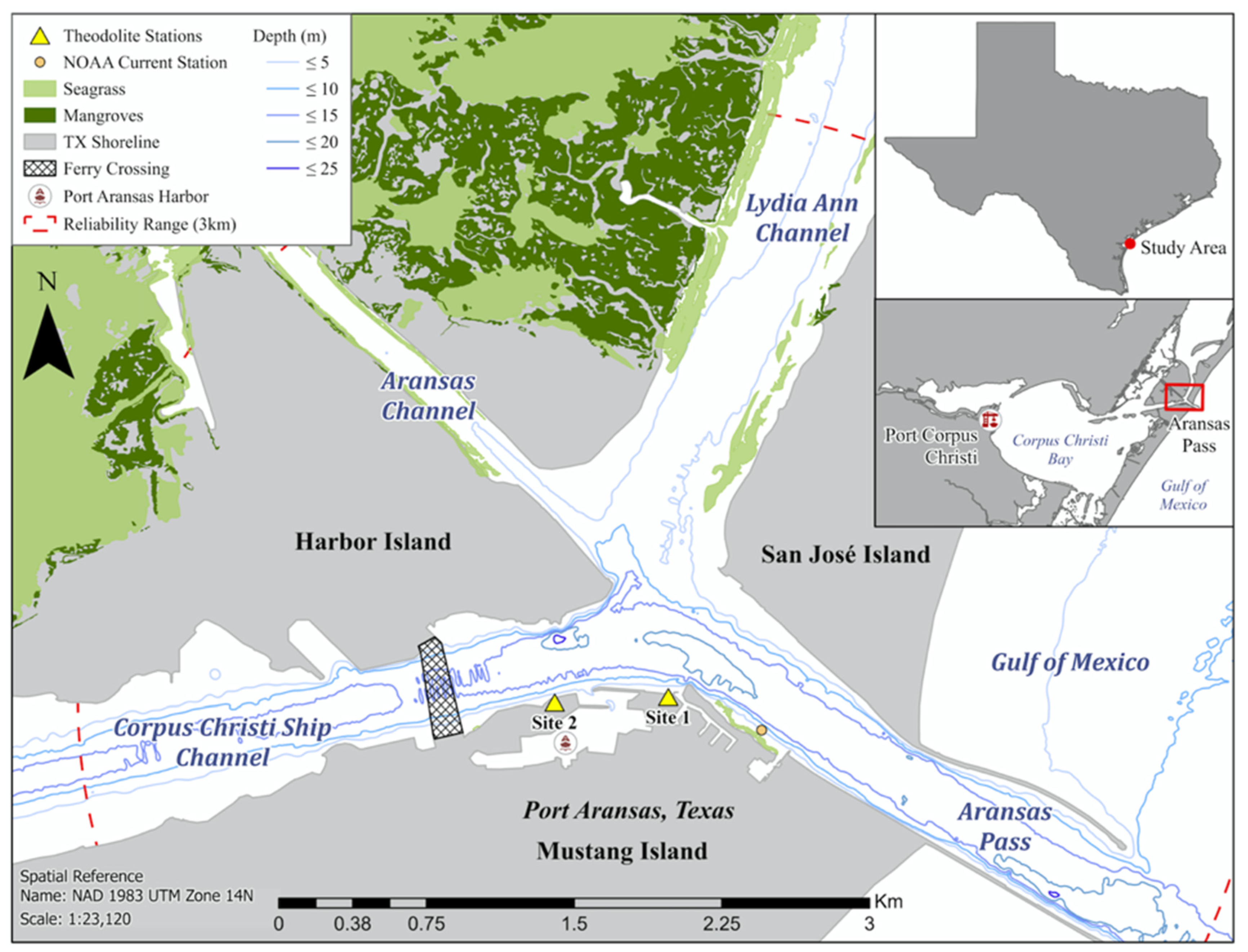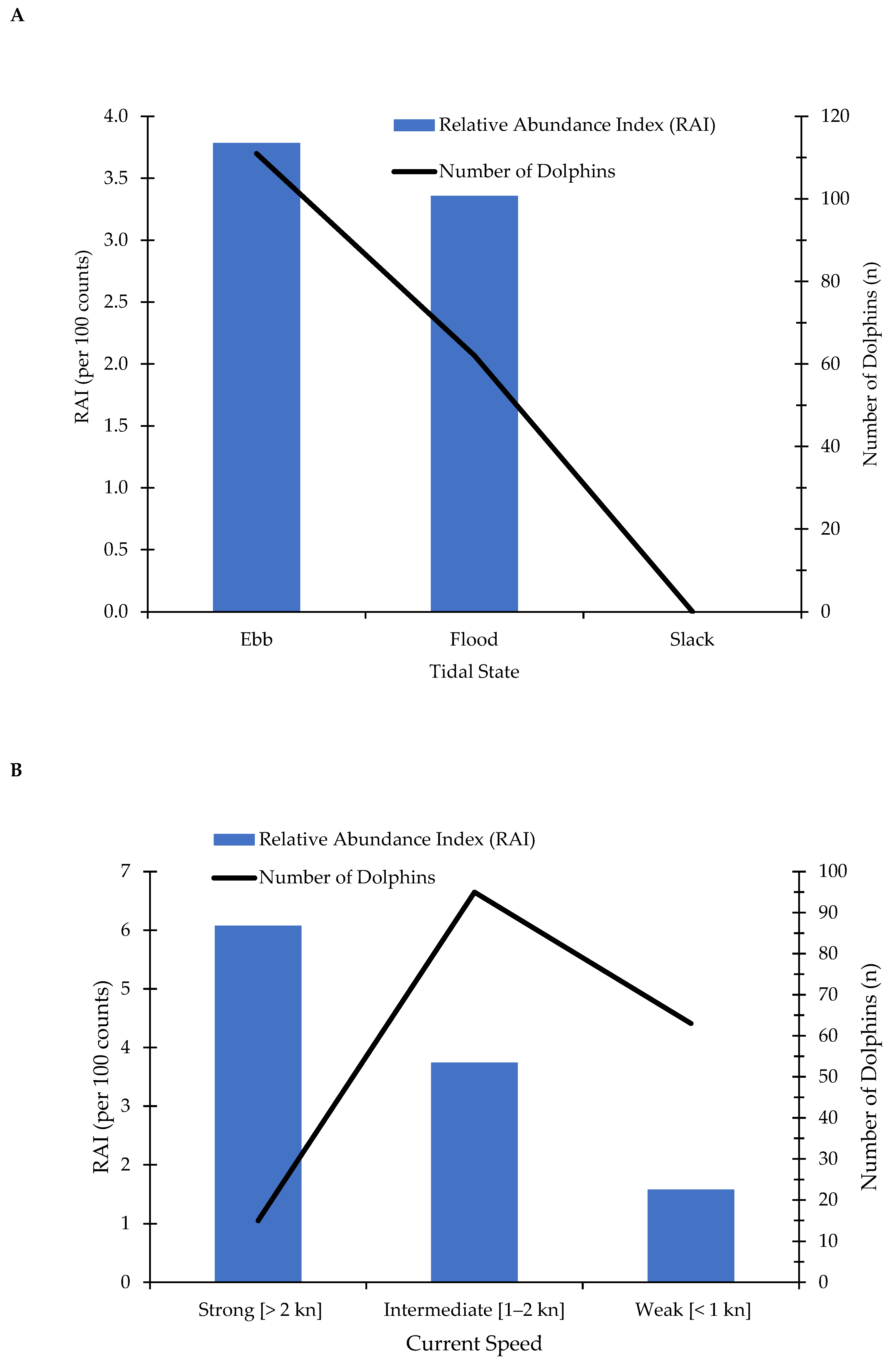Dolphins ‘Orient-Against-Current’: Foraging in Dredged Channels
Abstract
1. Introduction
2. Materials and Methods
2.1. Study Area
2.2. Sampling Method
2.3. Analyses
3. Results
3.1. Temporal Patterns of Orient-Against-Current
3.2. Habitat Spatial Patterns of Orient-Against-Current
4. Discussion
5. Conclusions
Supplementary Materials
Author Contributions
Funding
Institutional Review Board Statement
Informed Consent Statement
Data Availability Statement
Acknowledgments
Conflicts of Interest
References
- Torres, L.G.; Read, A.J. Where to catch a fish? The influence of foraging tactics on the ecology of bottlenose dolphins (Tursiops truncatus) in Florida Bay, Florida. Mar. Mamm. Sci. 2009, 25, 797–815. [Google Scholar] [CrossRef]
- Bailey, H.; Thompson, P. Effect of oceanographic features on fine-scale foraging movements of bottlenose dolphins. Mar. Ecol. Prog. Ser. 2010, 418, 223–233. [Google Scholar] [CrossRef]
- Hersh, T.A.; Marcondes, D.S.; Fonseca, G.F.; Valle-Pereira, J.V.S.; Kratofil, M.A.; Machado, A.M.S.; Atkins, S.; Bankhead, K.R.; McGarvey, K.; Rahman, M.M.; et al. Ecology and conservation of socially learned foraging tactics in odontocetes. Phil. Trans. R. Soc. B 2025, 380, 20240134. [Google Scholar] [CrossRef]
- Nowacek, D.P. Sequential foraging behaviour of bottlenose dolphins, Tursiops truncatus, in Sarasota Bay, FL. Behaviour 2002, 139, 1125–1145. [Google Scholar] [CrossRef]
- Ronje, E.I.; Barry, K.P.; Sinclair, C.; Grace, M.A.; Barros, N.; Allen, J.; Balmer, B.; Panike, A.; Toms, C.; Mullin, K.D.; et al. A common bottlenose dolphin (Tursiops truncatus) prey handling technique for marine catfish (Ariidae) in the northern Gulf of Mexico. PLoS ONE 2017, 12, e0181179. [Google Scholar] [CrossRef]
- Wells, R.S.; Scott, M.D. Bottlenose dolphin, Tursiops truncatus, common bottlenose dolphin. In Encyclopedia of Marine Mammals, 3rd ed.; Würsig, B., Thewissen, J.G.M., Kovacs, K.M., Eds.; American Press: San Diego, CA, USA, 2018; pp. 118–124. [Google Scholar]
- Shane, S.H.; Wells, R.S.; Würsig, B. Ecology, behavior, and social organization of the bottlenose dolphin: A review. Mar. Mamm. Sci. 1986, 2, 34–63. [Google Scholar] [CrossRef]
- Piwetz, S. Common bottlenose dolphin (Tursiops truncatus) behavior in an active narrow seaport. PLoS ONE 2019, 14, e0211971. [Google Scholar] [CrossRef] [PubMed]
- Wells, R.S. Common bottlenose dolphin foraging: Behavioral solutions that incorporate habitat features and social associates. In Ethology and Behavioral Ecology of Odontocetes; Würsig, B., Ed.; Springer Nature: Cham, Switzerland, 2019; pp. 331–344. [Google Scholar]
- Mills, E.M.M.; Piwetz, S.; Orbach, D.N. Behavioral hotspots of bottlenose dolphins in industrialized ship channels. Front. Mar. Sci. 2024, 11, 1334252. [Google Scholar] [CrossRef]
- Caruso, F.; Alonge, G.; Bellia, G.; Domenico, E.D.; Grammauta, R.; Larosa, G.; Mazzola, S.; Riccobene, G.; Pavan, G.; Papale, E.; et al. Long-term monitoring of dolphin biosonar activity in deep pelagic waters of the Mediterranean Sea. Sci. Rep. 2017, 7, 4321. [Google Scholar] [CrossRef]
- Pearson, H.C. Dusky dolphins of continental shelves and deep canyons. In Ethology and Behavioral Ecology of Odontocetes; Würsig, B., Ed.; Springer Nature: Cham, Switzerland, 2019; pp. 387–411. [Google Scholar]
- Sol, M.; Ollier, C.; Boisseau, O.; Ridoux, V.; Virgili, A. Temporal patterns in dolphin foraging activity in the Mediterranean Sea: Insights from vocalisations recorded during the ACCOBAMS Survey Initiative. Front. Mar. Sci. 2024, 11, 1378524. [Google Scholar] [CrossRef]
- Gregory, P.R.; Rowden, A.A. Behaviour patterns of bottlenose dolphins (Tursiops truncatus) relative to tidal state, time-of-day, and boat traffic in Cardigan Bay, West Wales. Aquat. Mamm. 2001, 27, 105–113. [Google Scholar]
- Carmen, M.; Berrow, S.D.; O’Brien, J.M. Foraging behavior of bottlenose dolphins in the Shannon Estuary, Ireland as determined through static acoustic monitoring. J. Mar. Sci. Eng. 2021, 9, 275. [Google Scholar] [CrossRef]
- Shane, S.H. The Population Biology of the Atlantic Bottlenose Dolphin, Tursiops truncatus, in the Aransas Pass Area of Texas. Master’s Thesis, Texas A&M University-Galveston, Galveston, TX, USA, 1977. [Google Scholar]
- Shane, S.H. Occurrence, movements, and distribution of bottlenose dolphin, Tursiops truncatus, in southern Texas. Fish. Bull. 1980, 78, 593–601. [Google Scholar]
- Gruber, J.A. Ecology of the Atlantic bottlenosed dolphin (Tursiops truncatus) in the Pass Cavallo area of Matagorda Bay, Texas. Master’s Thesis, Texas A&M University, College Station, TX, USA, 1981. [Google Scholar]
- Weiss, J. Foraging habitats and associated preferential foraging specializations of bottlenose dolphin (Tursiops truncatus) mother-calf pairs. Aquat. Mamm. 2006, 32, 10–19. [Google Scholar] [CrossRef]
- Weinpress-Galipeau, M.; Baker, H.; Wolf, B.; Roumillat, B.; Fair, P.A. An adaptive bottlenose dolphin foraging tactic, “shipside feeding,” using container ships in an urban estuarine environment. Mar. Mamm. Sci. 2021, 37, 1159–1165. [Google Scholar] [CrossRef]
- Connor, R.C.; Heithaus, M.R.; Berggren, P.; Miksis, J.L. Kerplunking: Surface fluke-splashes during shallow-water bottom foraging by bottlenose dolphins. Mar. Mamm. Sci. 2000, 16, 646–653. [Google Scholar] [CrossRef]
- Leatherwood, S.; Reeves, R.R. Abundance of bottlenose dolphins in Corpus Christi Bay and coastal Southern Texas. Contrib. Mar. Sci. 1983, 26, 179–199. [Google Scholar]
- Henderson, E.E.; Würsig, B. Behavior patterns of bottlenose dolphins in San Luis Pass, Texas. Gulf Mex. Sci. 2007, 25, 153–161. [Google Scholar] [CrossRef]
- Ronje, E.I.; Whitehead, H.R.; Barry, K.; Piwetz, S.; Struve, J.; Lecours, V.; Garrison, L.; Wells, R.S.; Mullin, K.D. Abundance and occurrence of common bottlenose dolphins (Tursiops truncatus) in three estuaries of the northwestern Gulf of Mexico. Gulf Carib. Res. 2020, 31, 18–34. [Google Scholar] [CrossRef]
- Mills, E.M.M.; Piwetz, S.; Orbach, D.N. Vessels disturb bottlenose dolphin behavior and movement in an active ship channel. Animals 2023, 13, 3441. [Google Scholar] [CrossRef] [PubMed]
- Mann, J.; Patterson, E.M. Tool use by aquatic animals. Phil. Trans. R. Soc. B 2013, 368, 20120424. [Google Scholar] [CrossRef]
- Smolker, R.; Richards, A.; Connor, R.; Mann, J.; Berggren, P. Sponge carving by dolphins (Delphinidae, Tursiops sp.): A foraging specialization involving tool use? Ethology 1997, 103, 454–465. [Google Scholar] [CrossRef]
- Krützen, M.; Kreicker, S.; MacLeod, C.D.; Learmonth, J.; Kopps, A.M.; Walsham, P.; Allen, S.J. Cultural transmission of tool use by Indo-Pacific bottlenose dolphins (Tursiops sp.) provides access to a novel foraging niche. Proc. Biol. Sci. 2014, 281, 20140374. [Google Scholar]
- Connor, R.C.; Sakai, M.; Morisaka, T.; Allen, S.J. The Indo-Pacific bottlenose dolphin (Tursiops aduncus). In Ethology and Behavioral Ecology of Odontocetes; Würsig, B., Ed.; Springer Nature: Cham, Switzerland, 2019; pp. 345–368. [Google Scholar]
- Allen, S.J.; Bejder, L.; Krützen, M. Why do Indo-Pacific bottlenose dolphins (Tursiops sp.) carry conch shells (Turbinella sp.) in Shark Bay, Western Australia? Mar. Mamm. Sci. 2011, 27, 449–454. [Google Scholar] [CrossRef]
- U.S. Army Corps of Engineers, Galveston District. USACE, Corpus Christi Celebrate Completion of Ship Channel Improvement Projects. Available online: https://www.swg.usace.army.mil/Media/News-Releases/Article/4200855/usace-corpus-christi-celebrate-completion-of-ship-channel-improvement-project/ (accessed on 2 June 2025).
- U.S. Coast Guard. Ports and Waterways Safety Assessment: Workshop Report Corpus Christi, Texas. United States Coast Guard Navigation Center, September 2019. Available online: https://navcen.uscg.gov/sites/default/files/pdf/pawsa/WorkshopReports/Corpus_Christi_Sep_2019.pdf (accessed on 1 August 2021).
- Tunnell, J.W., Jr.; Dokken, Q.; Smith, E.H.; Withers, K. Current status and historical trends of the estuarine living resources within the Corpus Christi Bay National Estuary Program study area. Tech. Rep. 1996, 1a. [Google Scholar] [CrossRef]
- NOAA National Ocean Service. Tides and Currents [Data Set]. Center for Operational Oceanographic Products and Services. Available online: https://tidesandcurrents.noaa.gov/map/index.html (accessed on 1 June 2022).
- Würsig, B.; Cipriano, F.; Würsig, M. Dolphin movement patterns: Information from radio and theodolite tracking studies. In Dolphin Societies: Discoveries and Puzzles; Pryor, K., Norris, K.S., Eds.; University of California Press: Berkeley, CA, USA, 1991; pp. 79–111. [Google Scholar]
- Harzen, S.E. Use of an electronic theodolite in the study of movements of the bottlenose dolphin (Tursiops truncatus) in the Sado Estuary, Portugal. Aquat. Mamm. 2002, 28, 251–260. [Google Scholar]
- Shane, S.H. Behavior and ecology of the bottlenose dolphin at Sanibel Island, Florida. In The Bottlenose Dolphin; Leatherwood, S., Reeves, R.R., Eds.; Academic Press: San Diego, CA, USA, 1990; pp. 245–265. [Google Scholar]
- Azzellino, A.; Gaspari, S.; Airoldi, S.; Nani, B. Habitat use and preferences of cetaceans along the continental slope and the adjacent pelagic waters in the western Ligurian Sea. Deep Sea Res. Part I Oceanogr. Res. Pap. 2008, 55, 296–323. [Google Scholar] [CrossRef]
- Sagnol, O.; Reitsma, F.; Richter, C.; Field, L.H. Correcting positional error in shore-based theodolite measurements of animals at sea. J. Mar. Biol. 2014, 2014, 267917. [Google Scholar] [CrossRef]
- ESRI-Environmental Systems Research Institute, Inc. How Kernel Density Works (Spatial Statistics). Available online: https://pro.arcgis.com/en/pro-app/latest/tool-reference/spatial-analyst/how-kernel-density-works.htm (accessed on 1 June 2022).
- Bushon, A. Recruitment, Spatial Distribution, and Fine-Scale Movement Patterns of Estuarine Dependent Species Through Tidal Inlets in Texas. Ph.D. Thesis, Texas A&M University-Corpus Christi, Corpus Christi, TX, USA, 2006. [Google Scholar]
- Payne, L.M. Evaluation of large-scale movement patterns of spotted seatrout (Cynoscion nebulosus) using acoustic telemetry. Master’s Thesis, Texas A&M University-Corpus Christi, Corpus Christi, TX, USA, 2011. [Google Scholar]
- Stokes, G.M. Life History Studies of Southern Flounder (Paralichthys lethostigma) and Gulf Flounder (P. albigutta) in the Aransas Bay Area of Texas; Texas Parks & Wildlife Department: Austin, TX, USA, 1977; Technical Series25; 37p, Available online: https://www.ccatexas.org/wp-content/uploads/2019/12/Technical-Series-No-25-Life-History-of-Southern-Flounder.pdf (accessed on 1 June 2022).
- Gabel, F.; Lorenz, S.; Stoll, S. Effects of ship-induced waves on aquatic ecosystems. Sci. Total Environ. 2017, 601–602, 926–939. [Google Scholar] [CrossRef] [PubMed]







Disclaimer/Publisher’s Note: The statements, opinions and data contained in all publications are solely those of the individual author(s) and contributor(s) and not of MDPI and/or the editor(s). MDPI and/or the editor(s) disclaim responsibility for any injury to people or property resulting from any ideas, methods, instructions or products referred to in the content. |
© 2025 by the authors. Licensee MDPI, Basel, Switzerland. This article is an open access article distributed under the terms and conditions of the Creative Commons Attribution (CC BY) license (https://creativecommons.org/licenses/by/4.0/).
Share and Cite
Mills, E.M.M.; Piwetz, S.; Orbach, D.N. Dolphins ‘Orient-Against-Current’: Foraging in Dredged Channels. Oceans 2025, 6, 78. https://doi.org/10.3390/oceans6040078
Mills EMM, Piwetz S, Orbach DN. Dolphins ‘Orient-Against-Current’: Foraging in Dredged Channels. Oceans. 2025; 6(4):78. https://doi.org/10.3390/oceans6040078
Chicago/Turabian StyleMills, Eliza M. M., Sarah Piwetz, and Dara N. Orbach. 2025. "Dolphins ‘Orient-Against-Current’: Foraging in Dredged Channels" Oceans 6, no. 4: 78. https://doi.org/10.3390/oceans6040078
APA StyleMills, E. M. M., Piwetz, S., & Orbach, D. N. (2025). Dolphins ‘Orient-Against-Current’: Foraging in Dredged Channels. Oceans, 6(4), 78. https://doi.org/10.3390/oceans6040078






